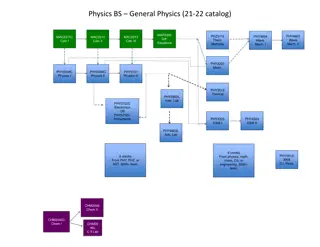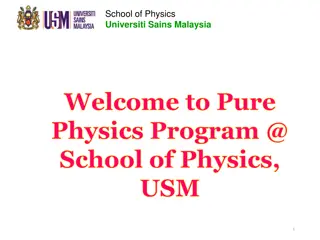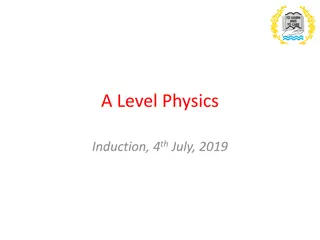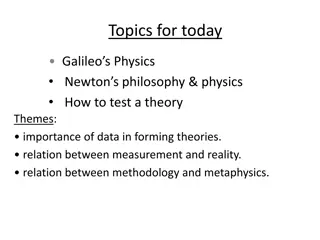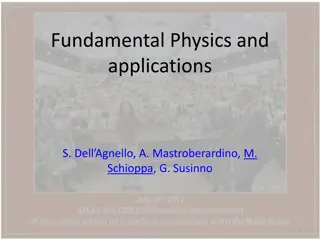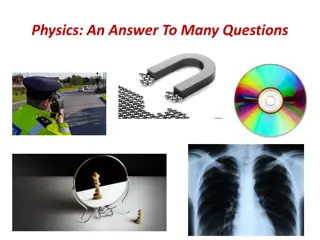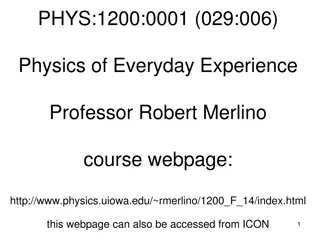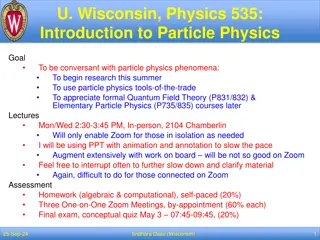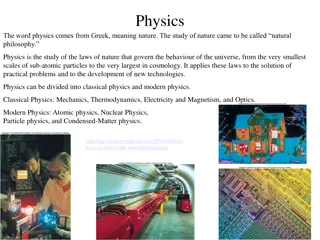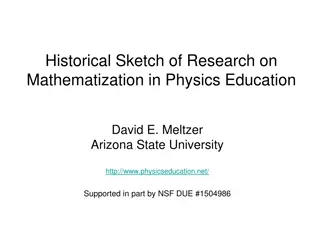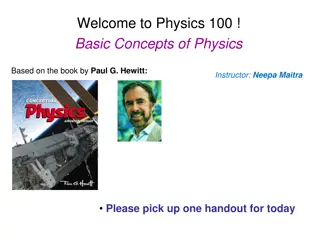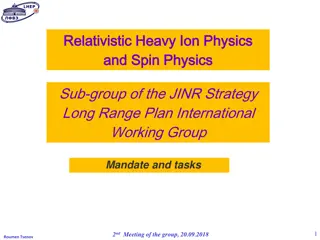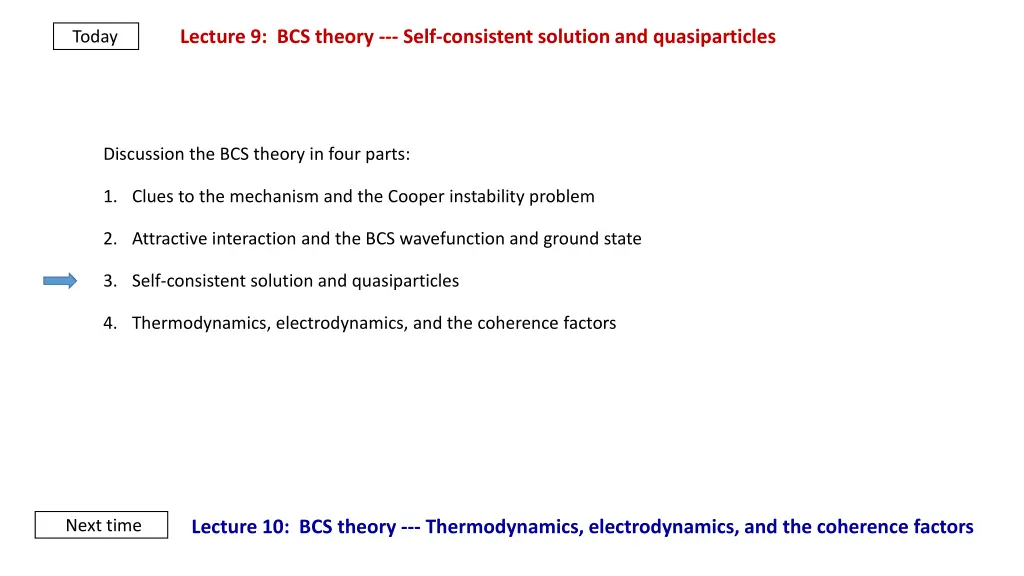
Understanding BCS Theory: Self-Consistent Solutions and Quasiparticles
Explore the self-consistent solutions and quasiparticles in the BCS theory, focusing on the mechanism, attractive interactions, and ground state. Dive into diagonalization, Bogoliubov-Valatin transformation, and solving for the ground state in this comprehensive discussion.
Download Presentation

Please find below an Image/Link to download the presentation.
The content on the website is provided AS IS for your information and personal use only. It may not be sold, licensed, or shared on other websites without obtaining consent from the author. If you encounter any issues during the download, it is possible that the publisher has removed the file from their server.
You are allowed to download the files provided on this website for personal or commercial use, subject to the condition that they are used lawfully. All files are the property of their respective owners.
The content on the website is provided AS IS for your information and personal use only. It may not be sold, licensed, or shared on other websites without obtaining consent from the author.
E N D
Presentation Transcript
Lecture 9: BCS theory --- Self-consistent solution and quasiparticles Today Discussion the BCS theory in four parts: 1. Clues to the mechanism and the Cooper instability problem 2. Attractive interaction and the BCS wavefunction and ground state 3. Self-consistent solution and quasiparticles 4. Thermodynamics, electrodynamics, and the coherence factors Next time Lecture 10: BCS theory --- Thermodynamics, electrodynamics, and the coherence factors
Last time ( ) + + = + 0 u k k v c c BCS ground state: G k k 1,... k k m 2 = probability that the pair state (?, ?) is occupied ?? 2+ ?? 2= 1 ?? 2 = probability that the pair state (?, ?) is empty ?? 1 2 k k c c + + + = + H V c c c c BCS (reduced) H: R k k k k , k k = E H to determine the ground state Variational calculation to minimize BCS G R G 11 2 = + 2 k = + u k 2 k 2 k E Found where k E k = 11 2 k V u v = 2 k v k and k E k Today Diagonalize HR excitation spectrum
Self-Consistent solutions = b c c : Key feature of the BCS state is electron correlations In the normal state these vanish (phases are random) k k k average ( ) = + + k b = c c c c b b k k k k k k k instantaneous time- averaged deviation (assume fluctuations small) ( )( ) + + + = + H c c V c c c c R k k k k k k k k ( ) + + + = + + * k * k k 2 c c V c c b b c c b b neglect terms of k k k k k k k k = k V k V b Define k to absorb parameter This is the model Hamiltonian: bilinear in ( k c c ( ) + + + ) = + * k * H c c c c c c k k b + + ( ) c c M k k k k and k k k k k k k ( ) H H H Diagonalize by a linear canonical transformation model red * kb Is to be determined self-consistently after we find the ground state
Bogoliubov-Valatin Transformation + + = + * k v c u 0 1 k k k k + + = + * k v c u 1 0 k k k k + + = + ' c k + c k v v + ks u --- obey anti-commutation relations Fermi operators 0 k k k INVERT 0,1 + = c c k u spin degrees of freedom (mix electron spins) 1 k k k k ( ) + + + = + * k * H c c c c c c k k b M k k k k k k k k + + + , Want to get rid of product states and keep only terms of form 1 0 1 0 k k k k + = * k k v 2 2 k 2 0 u v u Diagonalization condition: k k k k ( ) + + = + + + * ( ) H E k k b E Leads to: 0 0 1 1 M k k k k k k k k k
Solve diagonalization condition to get ground state + = * k k v 2 2 k 2 0 u v u k k k k 2 * k * k k v u * k k v u 2 + = 2 0 Multiply by k k 2 k u k k 2 + 2 k 2 4 4 * k k v u Solve by quadradic formula: = + + = 2 2 k k E = k k k k k (+ solution is stable) 2 k * k k v u u v , , Phases of related: for energy to be real, must be real k k k k real , v u BCS chose have the same phase factor k k k = v e u u = i ke v = i k k k k k 11 2 11 2 2 2 = = + = + 2 2 v k u k Solution: E k k k k k E E k k
( ) ( ) + + = + + + * H E k k b E Result of the diagonalization: 0 0 1 1 M k k k k k k k k k ( ) = = 2 E First term: Normal State k k k N k k k F 2 ( ) 1 + 2 k 2 k 2 Superconducting State k V k KE PE 1 2N ( ) 0 = 2 DIFFERENCE Ground state Condensation energy E = excitation energy, Second term: excitation numbers of Bogoliubov quasiparticles k Self consistency = E k V c c k k av energy gap + + = * 1 V u v k 0 0 1 1 k ave = k No ' as before qp s V u v k k
Quasiparticle operators ( ) , 0 1 k k + + = u c v c 0 k k k k + k + = + u c v c 1 k k k k k 0 0 = = 0 ( ) Define ground state by: ( ) 0 k G + + + + + e.g. c 0 u c v u v c c k k 0 k k 1 k G ( )0 ( ) + + + + = 0 u v u v c u v c c k k k k k k 0 0 + ( ) Define quasiparticle by: ( ) 0 k G + + + + e.g. 0 u c v c u v c c + k k k k k 1 k G ( ) ( ) + + + + + 2 k 2 k 0 u v c u v c c k k k k k k + state occupied, empty rest are unchanged from GS k k ko G ( )0 + + + + c u v c c k k k k k + state occupied, empty k k k 1 k G
Normal state Excitation picture describe excited states by addition of quasi-particles EXCITATIONS GROUNDSTATE OCCUPATION PROBABLILITY k + c 1 = N F k + k k k F k c k + k T 1 e B k c c k k k F kf k k E k = holes electrons 0 E ENERGY: k k k = Q e k 0 CHARGE: k k Q k 1 k = = V E v k VELOCITY: k k k k e k k 0 = = J ev Q V e CURRENT: k k k k
SUPERCONDUCTING STATE OCCUPATION PROBABILITY EXCITATIONS GROUND STATE 1 k T k + = F 0 k + E 1 e k B k k k 1 1 2 k k 2 kv k k E minimum excitation energy = + 2 k 2 E Energy: k k 0 2 k ( ) kE KE = = 1 2 = 2 k 2 k 2 v v k k k E k 2 k 2 k electron ground state = + = E E KE k E E 2 k k k ( ) PE = = 2 (lose pairing) u v PE k k k E k
electron GS ( ) = 1 2 = 2 k Q v e e k Charge: k E k Q k electron like qp s k Dependence of charge on means the qp changes charge as it accelerates k qp s not independent particles (many body system.) hole-like qp s k k 1 = = VELOCITY: V E v k k k k k E k Again, shows that qp s are not independent of condensate. = = CURRENT: J ev Q V ev k k k k k k E k QP s have mixed electron hole character
E Density of states: map over k k ( ) ( ) ( ) 0 = N E dE N d N d s k k N k k k d dE ( ) E ( ) 0 = k N N s k 0 E E E = N N = s ( ) E E s N 1/2 2 2 E N States below gap (NORMAL STATE) pushed up to peak at gap edge E Tunneling and transport are probes of this.
BCS Model GROUND STATE 1 2 E ( ) 0 11 2 = 2 c E N = + 2 k 2 k F = E 2 k k v k E k Self-consistency: , k E QUASIPARTICLES k mp ( ) T = = k Q e J ev Q V = k V v k k k k k k k E E k k cT E T for E ( ) N E = 2 2 E Next time: 0 for E Temperature dependence 1 k T ( ) = F E k + / E Thermodynamics phenomenological models 1 e k B External perturbations coherence factors (selection, modes)



